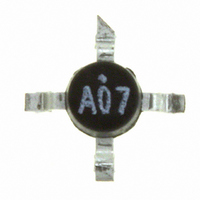AD8250-EVALZ Analog Devices Inc, AD8250-EVALZ Datasheet - Page 6

AD8250-EVALZ
Manufacturer Part Number
AD8250-EVALZ
Description
BOARD EVALUATION AD8250
Manufacturer
Analog Devices Inc
Series
iCMOS®r
Specifications of AD8250-EVALZ
Channels Per Ic
1 - Single
Amplifier Type
Instrumentation
Output Type
Single-Ended
Slew Rate
25 V/µs
-3db Bandwidth
10MHz
Current - Output / Channel
37mA
Operating Temperature
-40°C ~ 85°C
Current - Supply (main Ic)
4.1mA
Voltage - Supply, Single/dual (±)
10 V ~ 30 V, ±5 V ~ 15 V
Board Type
Fully Populated
Utilized Ic / Part
AD8250
Lead Free Status / RoHS Status
Lead free / RoHS Compliant
AD8250
ABSOLUTE MAXIMUM RATINGS
Table 3.
Parameter
Supply Voltage
Power Dissipation
Output Short-Circuit Current
Common-Mode Input Voltage
Differential Input Voltage
Digital Logic Inputs
Storage Temperature Range
Operating Temperature Range
Lead Temperature (Soldering, 10 sec)
Junction Temperature
θ
Package Glass Transition Temperature
1
2
3
Stresses above those listed under Absolute Maximum Ratings
may cause permanent damage to the device. This is a stress
rating only; functional operation of the device at these or any
other conditions above those indicated in the operational section of
this specification is not implied. Exposure to absolute maximum
rating conditions for extended periods may affect device reliability.
MAXIMUM POWER DISSIPATION
The maximum safe power dissipation in the AD8250 package is
limited by the associated rise in junction temperature (T
the die. The plastic encapsulating the die locally reaches the
junction temperature. At approximately 140°C, which is the
glass transition temperature, the plastic changes its properties.
Even temporarily exceeding this temperature limit can change
the stresses that the package exerts on the die, permanently
shifting the parametric performance of the AD8250. Exceeding
a junction temperature of 140°C for an extended period can
result in changes in silicon devices, potentially causing failure.
The still-air thermal properties of the package and PCB (θ
the ambient temperature (T
the package (P
The junction temperature is calculated as
Assumes that the load is referenced to midsupply.
Current must be kept to less than 6 mA.
Temperature for specified performance is −40°C to +85°C. For performance
to 125°C, see the Typical Performance Characteristics section.
JA
(Four-Layer JEDEC Standard Board)
T
J
= T
A
+ (P
D
) determine the junction temperature of the die.
D
× θ
JA
)
A
), and the total power dissipated in
3
Rating
±17 V
See Figure 4
Indefinite
+V
+V
±V
−65°C to +125°C
−40°C to +85°C
300°C
140°C
112°C/W
140°C
S
S
S
+ 13 V, −V
+ 13 V, −V
1
S
S
− 13 V
− 13 V
J
) on
JA
),
2
Rev. B | Page 6 of 24
The power dissipated in the package (P
quiescent power dissipation and the power dissipated in the
package due to the load drive for all outputs. The quiescent
power is the voltage between the supply pins (V
quiescent current (I
to midsupply, the total drive power is V
is dissipated in the package and some in the load (V
The difference between the total drive power and the load
power is the drive power dissipated in the package.
In single-supply operation with R
case is V
Airflow increases heat dissipation, effectively reducing θ
addition, more metal directly in contact with the package leads
from metal traces, through holes, ground, and power planes
reduces the θ
Figure 4 shows the maximum safe power dissipation in the
package vs. the ambient temperature on a four-layer JEDEC
standard board.
ESD CAUTION
P
P
Figure 4. Maximum Power Dissipation vs. Ambient Temperature
2.00
1.75
1.50
1.25
1.00
0.75
0.50
0.25
D
D
= Quiescent Power + (Total Drive Power − Load Power)
0
–40
=
OUT
(
V
= V
S
JA
×
–20
.
I
S
S
/2.
)
+
S
). Assuming that the load (R
⎛
⎜
⎜
⎝
0
AMBIENT TEMPERATURE (°C)
V
2
S
×
20
V
R
OUT
L
40
⎞
⎟
⎟
⎠
L
–
referenced to −V
V
OUT
R
60
L
D
S
) is the sum of the
/2 × I
2
80
OUT
S
) times the
L
, some of which
OUT
) is referenced
100
S
× I
, the worst
OUT
120
JA
. In
).













